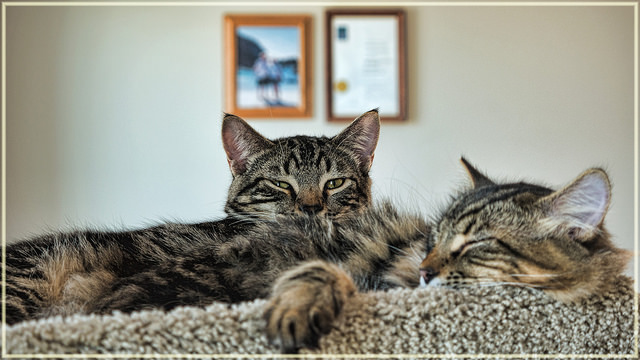Cats are territorial by nature, so multi-cat households can be full of tension even if the cats are bonded. If you’re not actively paying attention to subtle body language clues you may not even know it’s happening. The good news is that there are 6 simple steps you can take to ease the tension and keep the peace between all of your furry friends.

Image Source: Marnee Pearce via Flickr.com
1. Increase shared resources
The most common stressor in a multi-cat home is the demand to compete for shared resources such as food, the litter box, and vertical space. Competition for shared resources can cause your cats to be anxious and aggressive. You can easily solve this problem by adding more resources to your home. When you add extra resources to your home, disperse them throughout instead of grouping two food bowls in the kitchen, two litter boxes side by side in the bathroom, etc. The point of adding extra resources is to limit the possibility of one cat ever feeling like she can’t access a resource if it’s being guarded or watched by another cat. If she can’t access the food bowl in the kitchen, it’ll be good for her to know there is another food bowl in the spare bedroom.

Image Source: Dan4th Nicholas via Flickr.com
2. Use a pheromone plug-in
When cats rubs her face against you, she’s not just saying hi– she is marking you with a pheromone secreted from glands on the side of her mouth. These pheromones signal that she has decided that you’re safe. Pheromone sprays and plug-ins mimic these same pheromones and can coax an anxious cat into feeling secure. They’re very easy to use and can quickly deescalate territorial tension.

Image Source: Colin via Flickr.com
3. Uncovered litter box
Covered boxes work great for us because they can help reduce the amount of litter that gets kicked out onto the floor, but they can be a serious cause of fear and tension in a multi-cat home. A covered litter box limits your cat’s field of vision, making it harder for her to see if another cat approaches while she’s in there. It also leaves only one escape route, which can make her feel vulnerable and like a prime ambush target.
If you must use a covered box, consider one with a clear lid.

Image Source: Jim via Flickr.com
4. Ample hiding spots and perches
In a multi-cat home, it’s important to have many places from which a cat can scan her surroundings and avoid being seen. Many cats will find hiding spaces that already exist in your home (cupboards, under beds or couches, etc.) but it never hurts to add some if your home seems to be lacking. Perches can also come in many forms such as cat trees or a cleared off spot on your bookshelf. For some creative ideas, check out our recent article: 5 Simple Ways to Add Vertical Space for Your Cat

Image Source: frankieleon via Flickr.com
5. Individualized interactive playtime
Interactive playtime is an important part of raising healthy cats and helps strengthen their bond with you. Asking them to compete for toys, however, can cause intimidation and tension. Instead, set aside time during your day to play with each cat individually.
Cats who are very bonded may be able to engage in interactive play together. Just make sure each cat gets their fair share of the action.

Image Source: Jan de Boer via Flickr.com
6. Introduce new cats correctly
Introducing a new cat to the resident cats in your home is a process that shouldn’t be taken lightly. In fact, how you introduce a new cat to your household can make a huge difference in how easily and successfully the new cat blends into the established hierarchy. The ASPCA has a great 3 step program you can follow to ensure a successful introduction.
